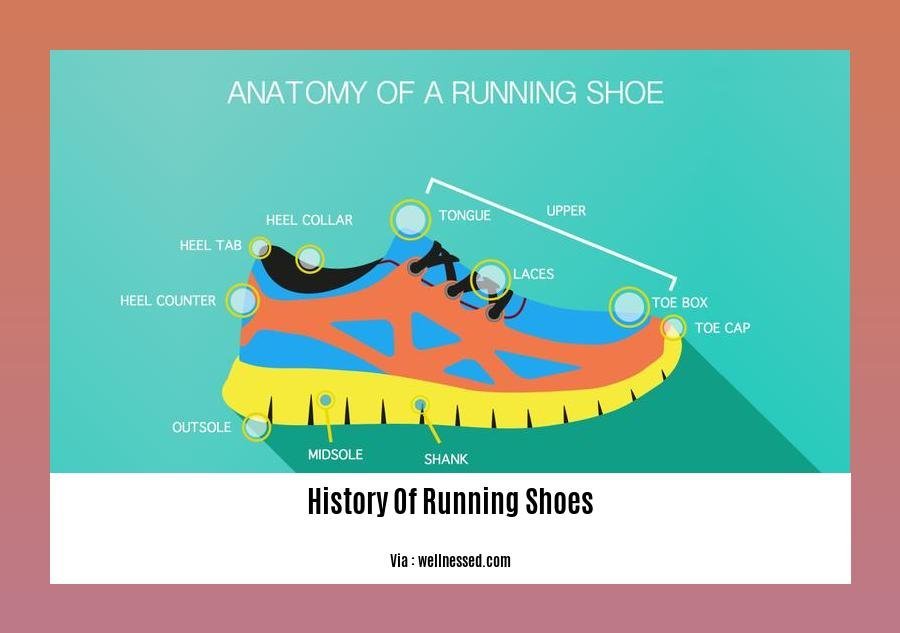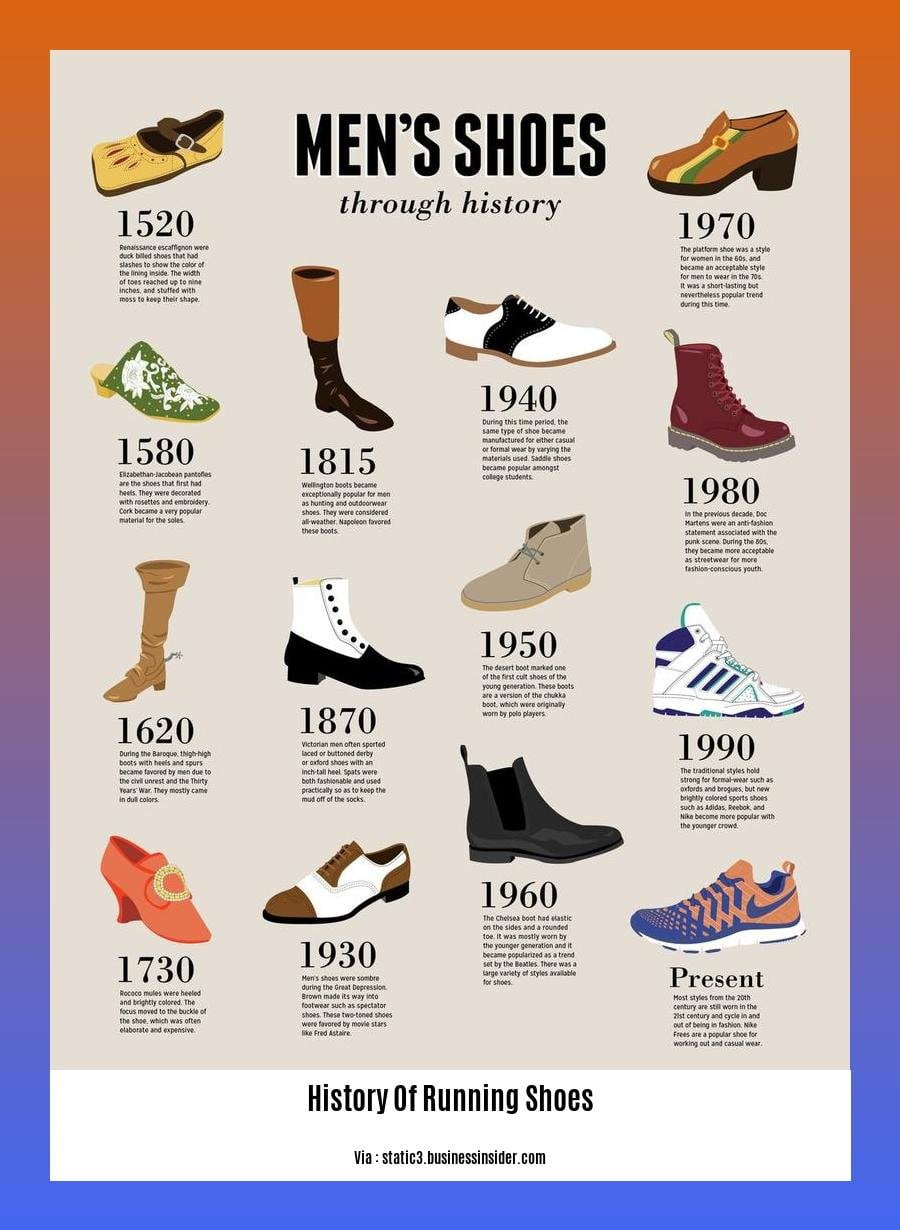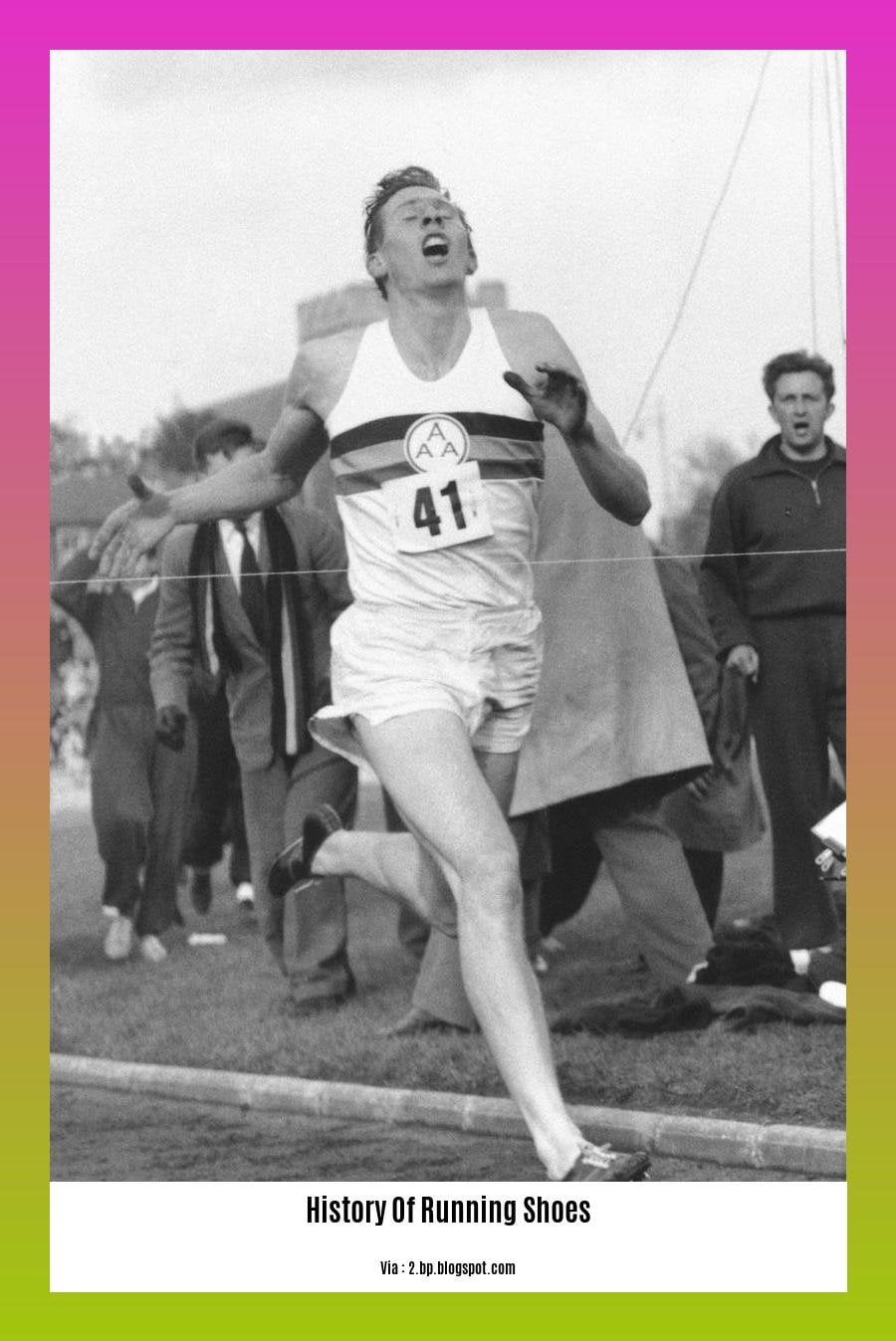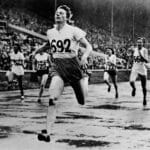Embark on a captivating journey through time as we delve into the fascinating history of running shoes, an integral part of athletic culture and human achievement. From humble beginnings to cutting-edge innovations, discover the stories behind the materials, designs, and iconic brands that have revolutionized the sport of running.
Key Takeaways:
- In 1852, the Spalding Company introduced the first shoes specifically designed for running, featuring spiked soles for enhanced traction.
- Keds, among the earliest forms of running shoes, gained popularity during 1917-1935, along with Plimsoll shoes.
- Adolf Dassler played a pivotal role in the development of specialized shoes for sports, including running shoes, from 1936-1949.
- The modern running shoe emerged from 1950 onwards, with advancements in technology and design leading to diverse options tailored to different needs.
- When selecting a running shoe, consider factors like foot type, running style, terrain, and pronation to ensure a suitable choice.
- Over time, running shoes have evolved significantly, incorporating new materials, technologies, and designs to improve performance and comfort for runners.
History of Running Shoes

Lace up and join us as we embark on a captivating journey through time, tracing the fascinating history of running shoes. From humble beginnings to modern marvels, these specialized footwear have played a pivotal role in shaping the world of athletics and human achievement.
Early Strides: Setting the Pace
In the year 1852, a spark ignited the world of running footwear when the Spalding Company introduced the first shoes specifically designed for runners. These pioneering shoes featured spiked soles, providing enhanced traction for athletes on various terrains.
Keds and Plimsolls: The Forerunners of Comfort
As the 20th century dawned, running enthusiasts embraced Keds, an early version of running shoes that prioritized comfort and versatility. Around the same time, plimsoll shoes also gained popularity among runners, owing to their lightweight construction and breathable canvas uppers.
1936-1949: A Pioneer Emerges
Adolf Dassler, a visionary in the realm of sports footwear, revolutionized the running shoe landscape. His innovative designs, emphasizing specialization and performance, laid the foundation for modern running shoes.
The Modern Era: A Symphony of Innovation
The post-war era witnessed a surge of technological advancements in running shoes. From lightweight materials to shock-absorbing midsoles, each innovation pushed the boundaries of performance, propelling runners to new heights.
Choosing the Perfect Fit: A Guide for Runners
Selecting the right running shoe is crucial for optimal performance and comfort. Consider these key factors:
- Foot Type: Understand your foot’s unique characteristics, such as arch type and pronation pattern.
- Running Style: Analyze your gait and stride to determine the appropriate cushioning and support levels.
- Terrain: Choose shoes designed for your preferred running surfaces, whether it’s roads, trails, or tracks.
- Pronation: If your feet roll inward excessively, opt for shoes with pronation control features.
A Legacy of Evolution: The Running Shoe Today
Over the decades, running shoes have undergone a remarkable transformation, incorporating advanced materials, technologies, and designs. Today, runners have access to a diverse range of shoes tailored to their specific needs, enabling them to achieve their full potential.
Celebrating Iconic Moments: Running Shoes on the World Stage
- In 1960, Abebe Bikila stunned the world by winning an Olympic marathon barefoot, showcasing the raw power of human determination.
- In 1972, Steve Prefontaine shattered world records in his signature Nike Waffle Racers, forever etching his name in running history.
- In 1998, Haile Gebrselassie broke the two-hour marathon barrier, wearing a pair of groundbreaking ASICS running shoes.
These iconic moments underscore the profound impact of running shoes on the sport, propelling athletes to achieve extraordinary feats.
Conclusion: A Testament to Human Ingenuity
The history of running shoes is a testament to human ingenuity and the relentless pursuit of excellence. From the humble beginnings of spiked soles to the sophisticated designs of today, these specialized footwear have transformed the world of running, enabling athletes to push their limits and achieve remarkable feats. As we continue to innovate and refine running shoe technology, the future holds endless possibilities for even greater achievements in the world of running.
Want to know the fascinating journey of Punta Gorda from its ancient roots to the bustling city it is today? Click on the link to uncover the rich history of Punta Gorda Florida and explore the tales that shaped this vibrant city!
From horse-drawn carriages to sleek modern vehicles, the evolution of road transport has revolutionized our world. Dive into the intriguing history of road transport to discover how transportation transformed societies and economies, connecting people and places like never before!
Unleash the captivating story of Royal Doulton, the renowned British manufacturer known for its exquisite ceramics and figurines. Through our comprehensive history of Royal Doulton, uncover the artistry, innovation, and craftsmanship that have made this brand a global icon, cherished by collectors worldwide.
Design features such as cushioning, arch support, and traction have been refined to enhance performance and reduce injuries.

Throughout history, advancements in the design of running shoes have played a crucial role in enhancing athletic performance and reducing the risk of injuries. Initially, running shoes were designed primarily for comfort and protection. However, as the sport evolved and athletes began pushing their limits, the need for specialized footwear became apparent.
Cushioning:
Cushioning in running shoes has undergone significant improvements. Early shoes offered minimal cushioning, leading to discomfort and increased impact on the joints. The introduction of foam materials, such as EVA (ethylene-vinyl acetate) and polyurethane, revolutionized cushioning. These materials absorb shock effectively, reducing stress on the feet and legs, enhancing comfort, and preventing injuries.
Arch Support:
Arch support in running shoes is crucial for maintaining proper foot posture and preventing common injuries like overpronation (excessive inward rolling of the foot). Initially, arch support was rudimentary or non-existent. However, advancements in shoe design and the use of materials like arch cookies and dual-density midsoles provide customized support, enhancing stability and reducing the risk of injuries.
Traction:
Traction is another critical aspect of running shoe design. Early shoes often had poor traction, leading to slips and falls. The introduction of rubber outsoles with specialized tread patterns, such as lugs and grooves, significantly improved traction. These patterns provide grip on various surfaces, ensuring stability, preventing slips, and enhancing performance.
Customization:
Modern running shoes offer a high level of customization to cater to the unique needs of individual runners. Factors like foot type, running style, and preferred terrain are considered in shoe design. Runners can choose from a wide range of shoes with varying levels of cushioning, arch support, and traction to achieve optimal performance and minimize injury risk.
Key Takeaways:
Cushioning: Advancements in cushioning materials, like EVA and polyurethane, have enhanced shock absorption, reducing stress on the feet and legs and preventing injuries.
Arch Support: The use of arch cookies and dual-density midsoles provides customized support, promoting stability and reducing the risk of overpronation.
Traction: Specialized tread patterns on rubber outsoles improve grip on various surfaces, ensuring stability, preventing slips, and enhancing performance.
Customization: Modern running shoes offer a range of options to accommodate individual needs, such as foot type, running style, and preferred terrain.
Sources:
Running Injury Paradigms and Their Influence on Footwear Design
Footwear comfort: a systematic search and narrative synthesis of the research literature
Iconic Brands like Adidas, Nike, and Asics have played a significant role in the development and marketing of running shoes.
In the ever-evolving world of running, iconic brands like Adidas, Nike, and Asics have marked their territory, leaving an indelible imprint on the sport’s history. Their influence extends far beyond the boundaries of mere footwear; they have shaped the narrative, pushed boundaries, and revolutionized the way runners experience their sport.
Adidas: A Legacy of Innovation and Performance
Adidas, a true titan in the sportswear industry, has been at the forefront of innovation since its inception. Their journey began in 1949 when Adi Dassler, driven by a burning passion for excellence, crafted the first track spikes specifically designed to enhance the performance of athletes. This groundbreaking innovation laid the foundation for Adidas’s legacy in the world of running shoes.
Nike: Emotional Branding and Technological Prowess
Nike, a brand that needs no introduction, has captivated the hearts and souls of runners worldwide. Their secret? An emotional connection forged through powerful storytelling, inspiring messages, and a relentless pursuit of technological advancements. Nike’s Waffle Racers, introduced in the 1970s, were a game-changer, featuring a unique sole designed to provide superior traction and cushioning. This innovation propelled Nike to the forefront of the running shoe industry, a position they have steadfastly maintained ever since.
Asics: A Fusion of Japanese Tradition and Cutting-Edge Technology
Asics, a Japanese powerhouse, has earned a reputation for blending traditional craftsmanship with cutting-edge technology. Their running shoes are meticulously engineered to provide unparalleled support, stability, and comfort. The Asics Gel technology, introduced in the 1980s, revolutionized cushioning in running shoes, effectively reducing impact forces and enhancing the runner’s experience.
Key Takeaways:
Iconic Brands: Adidas, Nike, and Asics have left an indelible mark on the history of running shoes.
Innovation: These brands have consistently pushed the boundaries of innovation, introducing game-changing technologies like track spikes, Waffle Racers, and Asics Gel.
Marketing Prowess: They have mastered the art of emotional branding, connecting with runners on a personal level and creating a loyal following.
Global Impact: Their influence extends far beyond national borders, shaping the global landscape of running footwear.
Unwavering Quality: Their commitment to quality and craftsmanship has earned them a reputation for excellence among runners worldwide.
Citations:
The Brand Analysis of Nike Based on Its Emotional Branding and Brand Personality
Running Injury Paradigms and Their Influence on Footwear Design
Technological advancements like air cushioning and carbon fiber plates have revolutionized the sport, enabling runners to achieve new levels of speed and efficiency.
From the humble origins of running in leather-soled shoes to today’s cutting-edge carbon fiber designs, the evolution of running shoes has been nothing short of remarkable.
The Air Revolution:
The introduction of air cushioning in the late 1970s marked a pivotal moment in the history of running shoes. The groundbreaking technology, pioneered by Nike, revolutionized the industry by providing runners with unprecedented levels of shock absorption and comfort. Air cushioning effectively reduced the impact on the foot and legs, allowing runners to push harder and run longer without compromising their well-being.
The Advent of Carbon Fiber Plates:
The arrival of carbon fiber plates in running shoes in the 2010s was another game-changer. This innovative material, known for its strength and flexibility, was initially used in high-performance running shoes designed for elite athletes. However, it soon trickled down to everyday runners, offering them the same performance benefits. Carbon fiber plates act as a propulsion mechanism, propelling runners forward with each stride, reducing energy loss, and enhancing overall efficiency.
The Impact on Running Performance:
The integration of air cushioning and carbon fiber plates has had a profound impact on running performance. Shoes equipped with these technologies have enabled runners to achieve new levels of speed and efficiency, breaking long-standing records and pushing the boundaries of human capability. In fact, research conducted by Nike revealed that the combination of ZoomX foam and carbon fiber plates in the Nike ZoomX Vaporfly NEXT% running shoes resulted in a remarkable 4% increase in running efficiency.
Key Takeaways:
- Air cushioning and carbon fiber plates have revolutionized running shoes, enhancing comfort, shock absorption, and efficiency.
- Carbon fiber plates act as a propulsion mechanism, reducing energy loss and propelling runners forward.
- The combination of ZoomX foam and carbon fiber plates has been shown to increase running efficiency by 4%.
- These technological advancements have enabled runners to achieve new levels of speed and efficiency, breaking long-standing records and pushing the boundaries of human capability.
Sources:
- The Runner’s Shop: The Carbon Fiber Running Shoe Revolution
- TechCrunch: How Nike Is Making Footwear to Improve Athletes’ Efficiency For the 2020 Olympics
FAQ
Q1: What era marked the development of specialized shoes for sports, including running shoes?
A1: Adolf Dassler played a significant role in the development of specialized shoes for sports, including running shoes, during the era from 1936 to 1949.
Q2: What factors should runners consider when choosing the right running shoe?
A2: To choose the right running shoe, runners should consider factors such as foot type, running style, terrain, and pronation.
Q3: What are the two major components of a running shoe?
A3: Running shoes consist of two major components: the upper, which covers the dorsum and heel of the foot, and the sole, which provides cushioning, support, and traction.
Q4: How did Nike’s emotional branding strategy contribute to its brand recognition?
A4: Nike’s emotional branding strategy, which involves storytelling and inspiring messages, helped create a strong connection with customers, contributing to the brand’s recognition and popularity.
Q5: What technology is commonly found in modern running shoes to improve running efficiency?
A5: Carbon fiber plates, often combined with foam cushioning like ZoomX, are commonly used in modern running shoes to improve running efficiency by increasing propulsion and reducing energy loss.
















